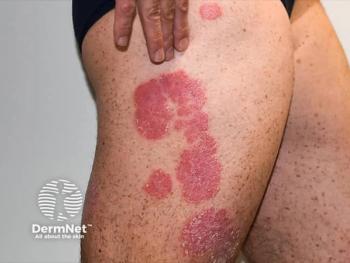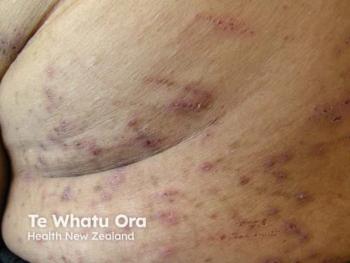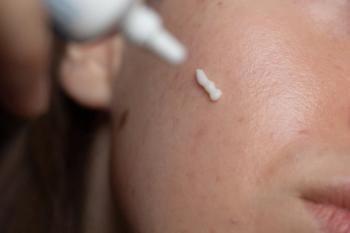
New Guidance Aims to Improve Genital Psoriasis Treatment
Key Takeaways
- Genital psoriasis is underreported and underdiagnosed, causing delayed treatment and significant psychosocial impact.
- The consortium recommends a distinct ICD-10-CM code and comprehensive skin exams for accurate diagnosis.
New guidelines from the Genital Psoriasis Wellness Consortium highlight the significant impact of genital psoriasis on patients, emphasizing improved diagnosis and personalized treatment.
Arcutis Biotherapeutics announced today the publication of 14 consensus statements developed by the Genital Psoriasis Wellness Consortium in the Journal of the European Academy of Dermatology and Venereology (JEADV) Clinical Practice. This set of statements represents the first comprehensive, expert-led guidelines dedicated specifically to genital psoriasis—a frequently overlooked and undertreated condition despite affecting an estimated 6 million Americans.1-2
The consensus initiative addresses a critical unmet need in dermatology. Genital psoriasis, affecting sensitive and private regions such as the vulva, penis, scrotum, perianal area, and intergluteal cleft, is often underreported by patients due to embarrassment and stigma, and it remains underdiagnosed by clinicians who may not routinely examine or inquire about genital involvement. This disconnect leads to delayed diagnosis, prolonged suffering, and substantial psychosocial impact.
To overcome these barriers, the consortium focused on 3 key areas: (1) physical diagnosis and patient communication, (2) the condition’s effect on quality of life and interpersonal relationships, and (3) treatment decision-making.
Physical Diagnosis and Patient Communication
The consortium emphasizes that genital psoriasis should be classified as a distinct condition, calling for a dedicated ICD-10-CM diagnosis code. Such a classification would improve epidemiological tracking, guide treatment development, and legitimize the condition’s clinical relevance. To ensure accurate diagnosis, the panel recommends incorporating comprehensive skin exams—including genital assessments—as routine practice for psoriasis patients. They stress the use of standardized dialogue guides to ease patient discomfort and normalize discussions about genital symptoms. Pediatric-specific guidelines include building trust and involving guardians in the examination process.
Biopsies are generally reserved for atypical presentations or when a differential diagnosis is necessary. Education and normalization are critical, particularly for sensitive populations like adolescents, who may experience heightened vulnerability during exams.
Impact on Quality of Life
Genital psoriasis exerts a disproportionate psychological and social burden compared to psoriasis on other body parts. The condition can significantly impair intimate and non-intimate relationships, influence decisions about clothing and activities, and elevate the risk for depression and social isolation.
The consortium advocates for early diagnosis to mitigate escalating psychological harm. They also propose integrating structured intake forms into electronic medical records (EMR) to capture the full impact of the disease from the outset. These include targeted questions on how genital psoriasis affects daily life, interpersonal dynamics, and overall well-being. Validated assessment tools—such as the Dermatologic Intimacy Scale and PHQ-9—are recommended for both clinical and research settings to ensure standardized evaluation.
Treatment Decisions and Shared Care Planning
Treatment selection should be personalized, incorporating patient preferences, treatment goals, and lifestyle considerations. While topical corticosteroids remain a frontline therapy, their long-term use on genital skin is limited by the risk of local adverse effects. Nonsteroidal alternatives and emerging agents such as topical roflumilast and systemic therapies like ixekizumab and apremilast are being explored, although more genital-specific data are needed.
Notably, the consortium emphasizes the necessity of shared decision-making in genital psoriasis care. Discussions around treatment should encompass family planning, tolerability, administration preferences, and safety profiles. The goal is rapid symptom resolution with sustained improvement, minimizing adverse effects while restoring quality of life.
Conclusion
With no existing formal treatment guidelines specifically for genital psoriasis, this consensus represents a significant advancement in standardizing and improving care. Supported by Arcutis Biotherapeutics, the initiative underscores the importance of multidisciplinary collaboration and patient-centered care. These expert-driven recommendations are intended as a living document, with updates anticipated as further clinical evidence emerges
References
- New consensus statements on impact of genital psoriasis on patients from Genital Psoriasis Wellness Consortium published in Journal of the European Academy of Dermatology and Venereology Clinical Practice. News release. Arcutis Biotherapeutics. Published May 15, 2025. Accessed May 15, 2025.
https://www.arcutis.com/new-consensus-statements-on-impact-of-genital-psoriasis-on-patients-from-genital-psoriasis-wellness-consortium-published-in-journal-of-the-european-academy-of-dermatology-and-venereology-clinical-prac/ - Cather J, Young M, Boreham M, et al. Genital psoriasis: Shining light on this hidden disease. JEADV Clinical Practice. 2025. doi:10.1002/jvc2.70043
Newsletter
Like what you’re reading? Subscribe to Dermatology Times for weekly updates on therapies, innovations, and real-world practice tips.


















